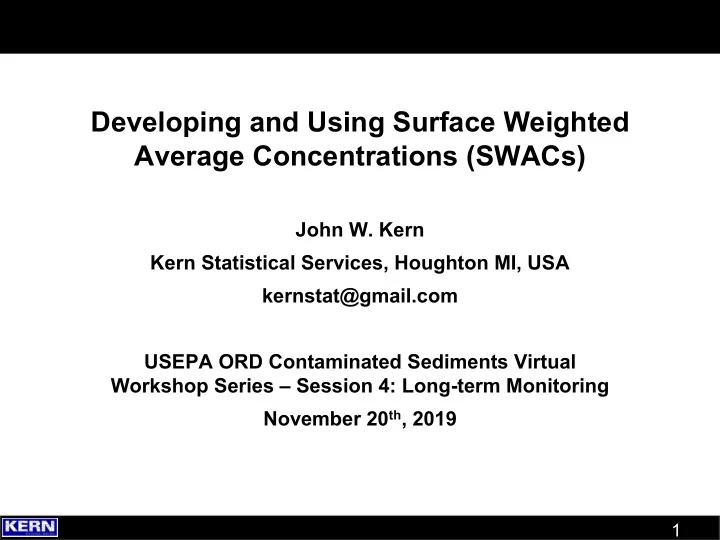

Developing and Using Surface Weighted Average Concentrations (SWACs) John W. Kern Kern Statistical Services, Houghton MI, USA kernstat@gmail.com USEPA ORD Contaminated Sediments Virtual Workshop Series – Session 4: Long-term Monitoring November 20 th , 2019 1 1
Presentation Overview: • SWAC Defined • Rationale for Spatial Weighting • Application for comparing remedial alternatives (SWAC vs RAL) • Uncertainty and need for confidence limits • Long term performance monitoring • Problems with biased sampling programs • Use of probability based sampling to develop unbiased SWAC estimates • Recommendations 2 2
What is a SWAC • SWAC ( Surface Weighted Average Concentration ) is a weighted average of sample data intended to estimate mean contaminant concentration over a specified spatial area. • As an exposure point concentration (EPC) confidence limits needed • Weights are intended to correct for spatial biases in RI/FS sampling programs. • Weights may be derived in one of several ways. • Weights proportional to polygons of influence (Thiessen Polygons). • Averaging over a map of interpolated values o Natural neighbor o Kriging o Inverse distance weighting • Spatial stratification of site data • Equally weighted arithmetic average • Geostatistical Simulation 3 3
Why use spatial weighting? • Sediment data evolve through many site investigations. • Spatial weighting used to correct spatial biases in sampling. 1993-1994 2001 2003 2008 4 4
SWAC vs Remedial Action Limit Relationship 5 5
Two Common Weighting Methods 6 6
Geostatistical simulation to evaluate spatial heterogeneity? False Positive False Negative 7 7
Recap • SWAC technique evolved out of efforts to de-cluster data generated from spatially biased sampling plans. • Particularly useful at the RI/FS stage of analysis where retrospective evaluation of the sample data is important for selecting a remedial alternative • Choice of weighting method matters • SWAC is a retrospective tool for integrating data from mixture of generally biased sampling programs • Spatial weighting does not fully correct for spatially biased sampling. • Statistical methods for bounding uncertainty are complicated How to make reliable temporal comparisons for monitoring purposes? 8 8
Temporal Change Conflated with Sampling Bias Unbiased Spatial Layout 4% Rate 8% Rate Active Remediation For long Term Monitoring probability based sampling and unbiased designs are needed 9 9
A small amount of unbiased data goes a long way! • For systematic sampling designs arithmetic average is the correct weighting • Usual Pro-UCL methods for confidence limits • Comparison of unbiased estimates for monitoring 10 10
Stratification To “Bias” Probability Based Sampling • Regular triangular grids within administrative strata • Greater sampling density within areas of greater interests for remediation • Overall averages obtained by area weighting stratum specific arithmetic averages. • Confidence limits based on bootstrap resampling or standard stratified sampling equations 11 11
Systematic Sampling Within Geomorphic Stratification A 2 A 1 + + A x A x A x = 1 1 2 2 3 3 SWAC A 3 + + A A A 1 2 3 12 12
Stratified Sample with One Sample Per Stratum • Unequal probability sampling design and corresponding unbiased estimator • One randomly located sample per cell (i.e. stratum) • Cell area weighted average is an unbiased estimator • Other weighting schemes are not advised • Confidence limits: • Student’s T or weighted bootstrap resampling. • Balanced Bootstrap with Importance Sampling. 13 13
SWAC Monitoring Recommendations • A portion of samples should be collected using a probability based sampling design. • SWAC estimation based solely on probability based data for trend evaluation • Re-occupy sites or not • Theoretically higher power obtained by re-occupying locations • In practice heterogeneity over small spatial scales may nullify gain in precision from re-occupying sites • Drawing new unbiased sample each time step provides better spatial coverage as time progresses • Complex site conceptual models can be accommodated through careful stratification of the sampling design • Comparisons based on differing sampling designs are valid provided each estimation procedure is unbiased to the corresponding sampling design 14 14
SWAC Monitoring Recommendations (continued) • Estimating trends in sediment concentration is a prospective endeavor • Plan for these studies developing unbiased sampling plans early • The unbiased data can be used in the RI/FS evaluations, • Temporal comparisons based on mixtures of biased and unbiased data are generally unreliable 15 15
Recommend
More recommend